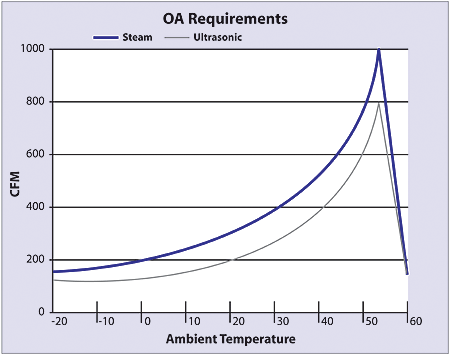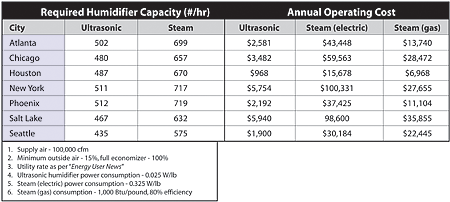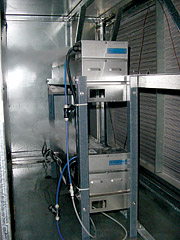
Just as there are many different kinds of spaces requiring proper humidity, there are many different ways in which humidification can be provided to a building. Each type of system has advantages and disadvantages, and as can be imagined, the costs to operate each type of system vary tremendously.
Ultrasonic humidification, which is an adiabatic type of system, is just one type of method available. These systems are known for using very little energy, and experts state that they also provide high-quality moisture and close control of an environment while requiring little maintenance. However, other factors such as first cost and water quality also have to be considered when figuring out how an ultrasonic humidifier will affect a building's total operating costs.
Some Higher Costs
Larry Cluchey, P.E., an independent consulting engineer in Grand Rapids, MI, who mainly focuses on solving humidity control problems, is a definite supporter of ultrasonic humidification systems."When I look at an application, I try to look at ultrasonic first to see if it's a right fit. If it's not, then I'll look at other systems. I tend to use ultrasonic on the smaller applications, say 150 lb/hour and down, just because it becomes a cost issue. The first cost gets a little high when you get into the bigger systems."
Indeed, the first cost of an ultrasonic humidification system is often much higher than other types of systems, particularly steam systems. Estimates usually show the first cost of an ultrasonic system (including water treatment) to be anywhere from two to four times higher than other types of systems.
That's why until recently, ultrasonic humidifiers were mainly considered for applications that could take advantage of their energy efficiency - only 7% of the electric usage of electric steam generators - to offset their high initial costs. However, over the last five years, the cost of ultrasonic humidifiers has come down considerably.
"Now that ultrasonic humidifiers are more cost effective, building owners are using them in applications where reduced maintenance, a healthy mist, or simplicity of installation is required," said David White, P.E., senior vice president of engineering, Humidifirst, Boynton Beach, FL. "Our typical clients include the baking industry, health care, fruit ripening rooms, printing rooms, laboratories, office buildings, and industrial manufacturing. We even have ultrasonic humidifiers in electronic rooms at the South Pole."
In addition to the higher first cost, ultrasonic humidifiers require ultra-pure water. White notes that smaller systems (30 lb or less) can use deionized (DI) water canisters, which clean the water to approximately 2.5 ppm. Larger ducted systems require an RO system, which can add approximately one-third or more to the cost of the humidifiers.
"Ultrasonic systems are a little less forgiving with regard to water treatment," stated James Mooney, P.E., president of Enginuity, LLC, an engineering-focused D-B mechanical services contracting firm in Mechanicsburg, PA. "If the water is not treated correctly through the use of DI canisters or RO, it can cause problems."

Lower Energy Costs
Where ultrasonic humidifiers really shine is in their low energy use. As White noted, ultrasonic humidification is the only way to make a steam size droplet (approximately 1 micron) without having to boil the water."Consider a typical 200 lb/hour humidifier," he said. "The electric steam humidifier will have an electric load of approximately 64 kW versus 5 kW for the ultrasonic humidifier. For a simple comparison, these systems, if operated at 3,000 hours per year would have an annual operating cost of $16,944 and $1,304 respectively. That is a 93% reduction of electrical usage."
Cluchey has devoted a lot of his time to studying how much it costs to generate each type of humidification. In fact, he has written an entire software program that performs the calculations based on humidification type. In his study, he determined that based on $0.065/kWh it costs about $0.17 to generate 100 lb of moisture using ultrasonics. Using the same cost per kW, electric steam (which Cluchey said people tend to buy first and hate later) costs $3.68 to generate 100 lb.
"Steam is always more expensive, whether you're using gas or electricity. Many people don't appreciate the fact that when you're humidifying, you are at a part-load cycle in the spring and the fall. The efficiencies of systems that are heating water to make steam aren't good, because they're constantly in a heat-up, cool-down scenario," stated Cluchey. "Even though you might have steam available as part of your steam plant for your heating system, it's still not necessarily the best application for humidification."
White added that while steam systems may have a much lower first cost, endusers need to consider how much it will cost to buy steam canisters. "Every time a steam canister needs to be replaced, it's necessary to buy it from the original manufacturer. That cost can be $150 to $400 for a steam canister. It makes the first cost look artificially low, because the system is being given away, and money is being made on the parts replacements."

Free Cooling
Another point to consider is how a building will benefit from the free-cooling effects of the ultrasonic humidifier evaporation process (approximately 1,000 Btu/lb of water evaporated). Some engineers may think of this as a heat loss, because heat is being taken out of the air to absorb the moisture, but that's not true, said Cluchey."In reality, in an economizer-based system, you generally will not see any kind of makeup energy penalty from an adiabatic system until you start bringing in more than 20% outside air as your minimum setpoint," he stated.
An economizer usually has a 15% or 20% minimum outside air setting, said Cluchey. As the air starts to warm up outside, the adiabatic cooling effect of the ultrasonic humidifier cools the air down to a point where the economizer senses that the discharge temperature is lower than the setpoint, so it reduces the outdoor air setting. The economizer then moves down to a point at which the discharge temperature is back at setpoint again.
"Basically, the economizer system will ratchet back and forth to satisfy its discharge temperature. The whole time, though, the adiabatic cooling effect has actually caused the system to bring in less outdoor air, and as a result we have to humidify less, because really, we have less outdoor air as a load," said Cluchey.
White added, "When in full econocycle, the ultrasonic humidifier produces its maximum operating cost savings when compared with steam systems. Assuming a utility cost of $0.08 per kWh, a 200 lb/hour steam humidifier will cost $5.12 per hour to operate versus the ultrasonic humidifier's $0.40 per hour to operate. In addition, there will be reduced run time of the ultrasonic humidifier due to the cooling effects that it provides."
Mooney cited an industrial application in which the free cooling effect of an ultrasonic humidification system was clearly evident. "We actually wound up delivering 30% less air because of the adiabatic cooling effect. Not only were we adding humidification, we were able to cool the space down with the humidity delivered. There were multiple benefits: A reduction in fan and chiller energy as well as a reduction in equipment size/cost. We were also able to maintain pretty close space control." (Figures 1 and 2.)
Jim Marsh, regional sales manager, Stulz Air Technology Systems (Frederick, MD) stated that as an added benefit, many electric utilities offer rebates for the application of ultrasonic humidification instead of electric steam humidifiers. "The payback on retrofits and new installations typically ranges from six months to two years, depending on hours per year of operation and cost of energy, when compared to electric steam humidifiers."

Other Things to Consider
The total impact that an ultrasonic humidification system will have on a building's operating costs ultimately depends on the type of application it is being used in, as well as the geographic location. While many different applications can benefit from the use of ultrasonic humidification, those that will save the most money in operating costs are generally those with high utility costs, long operating hours, and a cooling load that will exist during part or most of the humidification season.Mooney said he often specifies ultrasonic humidification systems in places such as the Northeast, where some level of humidity is required in the winter. In most cases, the buildings involved utilize an economizer with a minimum outside air position of about 15% in the winter. "It's almost always a retrofit for systems not originally designed, or installed, to allow for humidification. Usually, there are no reheat coils for close discharge control. And, in most cases, it is difficult just trying to figure out how to get a humidifier somewhere either in the ductwork or in the unit as a retrofit."
Facilities in other regions may have to take different issues into consideration when looking at an ultrasonic humidification system. One of those issues is the adiabatic effect that could take place in the ductwork if humidifying during the summer months. "Sometimes the discharge air is so cool, it actually winds up condensing on the insides of the ductwork. In an application where you need to humidify while in cooling mode, you have to be careful with the temperature and velocity of the air delivered as well as the quantity of humidification; it's a closer balance," noted Mooney.
It is in situations like this, he added, that consideration should be given to adding humidity directly to the space with console-type humidifiers or a separately ducted humidification system. This way the need for reheating the air is eliminated, and it's possible to take full advantage of the adiabatic effect. Additionally, it's easier and simpler to control.
Cluchey does add that regardless of application, ultrasonic systems will always save more money than steam systems. "You're going to get the same ratios of energy regardless of what the load is. If it's electric steam versus adiabatic, the ratio is the same. Look at a cleanroom. Typically, they have a fair amount of outdoor air because of makeup and pressurization. They like to run a little higher humidity levels many times than what they would run in an office building, so their loads might be higher, but the comparison is the same."
In addition to lower energy costs, Mooney stated that he likes the close control he can achieve with an ultrasonic humidification system. "It's almost instantaneous. You turn the power on, and you get humidity. There's no waiting to heat something up, it just goes." He said the low maintenance costs are also a plus, and that the cost for power wiring an ultrasonic system is "significantly less than anything else."
Cluchey added, "My experience has been if the ultrasonic systems are installed correctly, they give you extremely good reliable service. Engineers often don't look at these systems, because they're busy, and it's easy to default back to what they've been doing for years. But they should know there are alternatives out there." ES
For more information, Larry Cluchey, P.E. can be reached at Larry Cluchey, P.E. (e-mail) or 800-575-6808 (phone); James Mooney, P.E. can be reached at James Mooney, P.E. (e-mail) or 717-796-9226 (phone).

